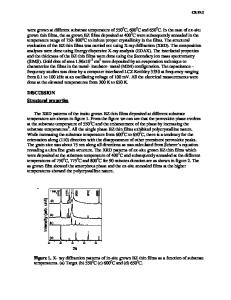Rapid Growth of Diamond-Like-Carbon Films by Copper Vapor Laser ablation
- PDF / 947,843 Bytes
- 5 Pages / 414.72 x 648 pts Page_size
- 39 Downloads / 396 Views
W. MCLEAN, B. E. WARNER, M. A. HAVSTAD, M. BALOOCH University of California, Lawrence Livermore National Laboratory, P.O. Box 808, L-460, Livermore, CA, 94550.
ABSTRACT Visible light from a copper vapor laser (CVL) operating with 510 and 578 nm radiation (intensity ratio approximately 2:1), an average power of 100 W, a pulse duration of 50 ns, and a repetition frequency of 4.4 kHz has been shown to produce high quality diamond-like-carbon (DLC) films at fluences between 2x10 8 and 5x10' 0 W/cm 2 . Maximum deposition rates of 2000 gm.cm 2/h were obtained at 5x10 8 W/cm 2. DLC films with hardness values of approximately 60 GPa were characterized by a variety of techniques to confirm DLC character, hydrogen content, and surface morphology. The presence of C2 in the vapor plume was confirmed by the presence of the C2 Swan bands in emission spectra obtained during the process. Economic implications of process scale-up to industrially meaningful component sizes are presented.
INTRODUCTION PLD of DLC films has been demonstrated with both ultraviolet and infrared light from both excimer and Nd:YAG lasers'- 5 with irradiances on the ablation target of 2x10 8 to over 10"1 W/cm 2 respectively. One major impediment to commercialization of PLD processes for DLC (and other materials as well) is the rate at which material can be deposited on a substrate by these commercially available photon sources. This issue has been addressed by employing the visible light output of high power CVLs. By demonstrating peak deposition rates on the order of 1 gm/min, this work lays the foundation for follow-on development of PLD processes by less complex pulsed lasers operating in the visible wavelength regions at high pulse repetition frequencies (PRFs).
EXPERIMENTAL PROCEDURES The characteristics of the CVLs employed in this work are summarized in Table I. Approximately 190 W (average power) of light from a single CVL oscillator and 500 W amplifier was directed through a fused Si0 2 window to a vacuum chamber on a rotating graphite target (POCO AXM-5Q, 5 g.nm average particle size) moving at a speed of 8 cm/s. Target texturing was minimized by exposing fresh tracks of graphite by indexing the target one beam diameter every revolution. Substrates were biased to - 500 V during the ablation process and to + 40 V between laser pulses. Table I. CVL Operating Parameters Wavelength 510, 578 nm (2:1 intensity ratio) Pulse Width 50 ns (FWHM) Pulse Energy 25mJ Pulse Repetition Frequency 4400 Hz 121
Mat. Res. Soc. Symp. Proc. Vol. 388 ©1995 Materials Research Society
A 500 mm focusing lens outside the vacuum chamber was used to set peak irradiances on the target by adjusting the beam diameter from 50 gm (5x1010 W/cm 2) to 750 gm (2x10 8 W/cm 2 ). Target-to-substrate spacing was typically 7.6 cm. Film thickness and distribution data on Si(100) substrates were obtained by masking the substrates and measuring the step height from the bare Si to the coating surface with a standard laboratory profilometer. All depositions were performed at ambient temper
Data Loading...










